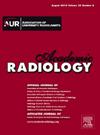利用弥散张量成像评估老花眼患者的白质完整性
IF 3.8
2区 医学
Q1 RADIOLOGY, NUCLEAR MEDICINE & MEDICAL IMAGING
引用次数: 0
摘要
理由和目的:本研究旨在使用弥散张量成像(DTI)评估被诊断为老花眼(老年性听力损失)患者的白质微结构完整性,并研究 DTI 参数与听力损失严重程度之间的关系:年龄在 50 岁及以上的老花患者(纯音平均值 [PTA] ≥20dB)被分为轻度(PTA 20-34dB)、中度(PTA 35-49dB)和重度(PTA ≥50dB)。测量了 16 个白质区域的分数各向异性(FA)、平均扩散率(MD)、轴向扩散率(AD)和径向扩散率(RD)。采用多元线性回归评估了 DTI 参数与语言辨别力评分之间的关系,并对年龄、性别和血管风险状况进行了调整:研究共纳入 148 名患者(轻度 32 人,中度 84 人,重度 32 人)。DTI 分析显示,与轻度组和中度组相比,重度组患者左侧扣带回的 FA(p = 0.001)和右侧 IFOF(p = 0.003)明显较低,而重度组患者左侧扣带回的 RD 较高(p = 0.006)。轻度组的左侧 IFOF RD 明显较低(p 结论:轻度组的左侧 IFOF RD 明显高于中度组(p = 0.003):本研究表明,不同严重程度的老花眼患者的白质微观结构均有明显改变。要全面了解与老花眼相关的认知和中枢听觉功能障碍,还需要进一步的研究。本文章由计算机程序翻译,如有差异,请以英文原文为准。
Evaluation of White Matter Integrity by Using Diffusion Tensor Imaging in Patients with Presbycusis
Rationale and Objectives
This study aims to evaluate white matter microstructure integrity in patients diagnosed with presbycusis (age-related hearing loss) using diffusion tensor imaging (DTI) and to investigate the relationship between DTI parameters and hearing loss severity.
Materials and Methods
Patients aged 50 and above with presbycusis (pure-tone average [PTA] ≥ 20 dB) were categorized as mild (PTA 20–34 dB), moderate (PTA 35–49 dB), or severe (PTA ≥ 50 dB). Fractional anisotropy (FA), mean diffusivity (MD), axial diffusivity (AD), and radial diffusivity (RD) were measured in 16 white matter regions. The relationship between DTI parameters and speech discrimination scores was assessed using multiple linear regression, adjusting for age, sex, and vascular risk profile.
Results
The study included 148 patients (mild = 32, moderate = 84, severe = 32). DTI analysis showed significantly lower FA in the left cingulum (p = 0.001) and right IFOF (p = 0.003) in the severe group compared to the mild and moderate groups, while RD in the left cingulum was higher in the severe group (p = 0.006). The mild group exhibited significantly lower left IFOF RD (p < 0.001) compared to the moderate and severe groups, and significantly lower left cingulum body MD (p = 0.004) compared to the severe group. Significant associations were found between speech discrimination scores and DTI parameters, including right hippocampal cingulum MD (p = 0.030), left IFOF RD (p = 0.033), right Heschl’s gyrus MD (p = 0.018), and AD (p = 0.008).
Conclusion
This study demonstrated significant alterations in white matter microstructure across different severities of presbycusis. Further research is needed to fully understand the cognitive and central auditory dysfunctions associated with presbycusis.
求助全文
通过发布文献求助,成功后即可免费获取论文全文。
去求助
来源期刊

Academic Radiology
医学-核医学
CiteScore
7.60
自引率
10.40%
发文量
432
审稿时长
18 days
期刊介绍:
Academic Radiology publishes original reports of clinical and laboratory investigations in diagnostic imaging, the diagnostic use of radioactive isotopes, computed tomography, positron emission tomography, magnetic resonance imaging, ultrasound, digital subtraction angiography, image-guided interventions and related techniques. It also includes brief technical reports describing original observations, techniques, and instrumental developments; state-of-the-art reports on clinical issues, new technology and other topics of current medical importance; meta-analyses; scientific studies and opinions on radiologic education; and letters to the Editor.
 求助内容:
求助内容: 应助结果提醒方式:
应助结果提醒方式:


